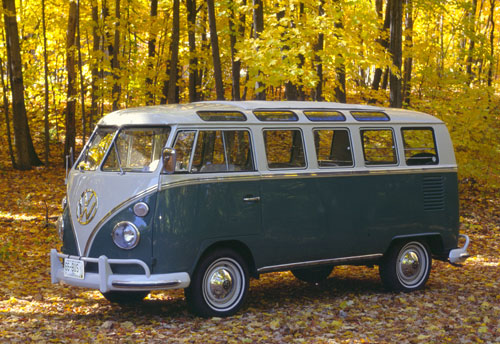
James H. Alton II, of San Dimas, CA, sent in his story of his 1966 VW 21-Window Bus:
I’ve had this 1966 microbus (chassis # 256102727) since 1987 or so, when I bought it from an Air Force colonel who worked at the Pentagon (I was a captain at Wright-Patterson Air Force Base). The fuel pump died en route back to Dayton and I had to call a friend to get me the last 100 miles home. The engine suffered from too much fuel in the oil and threw a rod not long afterwards.
It wasn’t till 2000 that serious restoration started. I thought I could escape California and left it with Lenny Copp at West Coast Classic Restoration. Then, on one warm December Day in 2002 (really, it was over 70 degrees) my bus arrived at my home in Hollis, NH. Those pictures were taken in my driveway there, about 30 feet out of the garage.
My bus has a slightly oversized (1,776-cc) engine. I rarely drive it with much of a load, so it’s not nearly as slow as people think. I’ll cruise at 60 to 65 mph on the speedometer but I can take it over 70 mph when I need to get out of the right lane.
My biggest impression is that it’s easy and low effort to drive. The engine has a flat (if not especially tall) torque curve, so there’s not a whole lot of gear shifting and the clutch and gearshift are easy. There’s play in the steering, as there is a sort of dead zone between turning left and turning right, but the bus has always seemed stable to me. It’s kind of like a serendipitous coincidence that it’s heading where I want it to go.
The driving position with the big, horizontal steering wheel is like driving a cocktail table. My bus is a 7-passenger “walk through,” and I usually get in and out through the middle door then walk forward like an airline pilot. It’s really handy to park the bus on the left edge of my cramped garage and not have to use the driver’s door.
It’s reasonably quiet for a utilitarian car of the 1960s and the ride’s pretty good unless you hit something that makes it pitch up. The driver’s seat ahead of the front axle means you’ll feel that. With all that space inside—- and low purchase and operating costs—- it’s no wonder the hippies chose them to cross the prairies and settle Haight-Ashbury. It’s a great environment to share a journey with friends—- if you’re not in a huge hurry or fighting modern traffic.
There aren’t many cars that get noticed like a Deluxe Microbus—- almost to the point of causing accidents because people are looking at it instead of where they’re going.
On the darker side, I entered it in the Palos Verdes Concours d’Elegance this September. It was like detailing a billboard that leaks oil, and those 21 windows were all surrounded with rubber weather stripping that had to be scrubbed [almost] clean. I had to get two cars there, so a friend drove the bus while I drove my 911. As I’ve said, I have always thought the bus is stable and controllable enough, but Alfred didn’t share that assessment—- he was afraid to go over 50!
1966 was the last year of ivory plastic knobs and a twin-shaft radio, so the interior has a more vintage ambience than a ’67 with its black rubber knobs and DIN radio.
Some details: My bus is in its original color scheme of Pearl White (a greenish white) over Velvet Green. The bumpers and wheels are correctly “Silver White,” which isn’t greenish. The interior is “Platinum Mesh” which is actually a gold/tan color instead of the silver grey that the word “platinum” suggests.
Why don’t you share your car story and become the next Collector of the Week? Send us a photo of you and your car, a short description of the car and your thoughts on performance. Check back next week, as you may be our next featured collector!